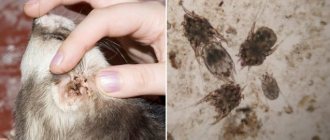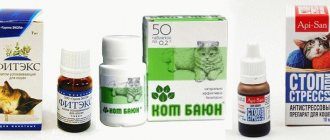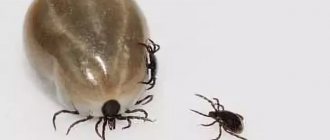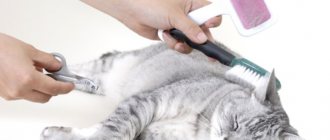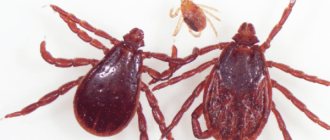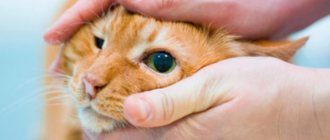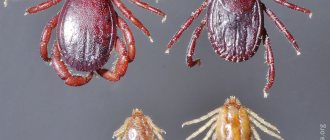If your indoor cat is clearly bothered by his ears, the most likely cause of the discomfort may be otodectosis, which is caused by mites. In this case, the pet requires immediate help. Infection with ear parasites dramatically reduces the quality of life of an animal and can even lead to its death. You will learn how to identify the symptoms of the disease and what medications to successfully treat it from our article.
What mites look like in cats' ears, photo
You can get an idea of what ear mites look like in cats from common photos and descriptions of the parasite. Therefore, if the first similar symptoms appear, the animal should be carefully examined. It is advisable to take him to a veterinarian who can make an accurate diagnosis.
It is also quite possible to detect a bug on your own. It has an oval body of microscopic size (up to 0.6 mm) of a yellowish tint, 8 limbs and 2 pedipalps. In most cases, the parasite is found in the animal's ear folds.
This is interesting: ear mites are very tenacious. While waiting for its prey, it can go without food for just over two months. And if he does not find a “carrier” during this time, he will die.
Preventive measures
Otodectosis can be prevented even without using drops - it is enough to follow preventive measures. Since the disease is quite contagious, it is better to prevent your pet from coming into contact with other animals. During a walk, you should keep the cat on a leash or choose a clearing without tailed cats, and also prevent self-walking. Sometimes even a couple of minutes is enough for ear parasites to settle on delicate skin.
What else the owner can do is to more closely monitor the immunity of domestic cats. Review your diet and try adding more nutrients to it. You can also give a separate complex of vitamins and minerals for animals. Remember to regularly inspect and clean your ears.
Prevention of ear mites includes treating all four-legged animals in the house if the parasite is detected in only one pet. For example, you have 3 cats and a dog, which means everyone needs to take drops, otherwise you will endlessly remove the parasite from each one in turn.
Regular washing of the bed and washing the carrier can also reduce the likelihood of infection. Also, try not to allow your indoor cat to have access to your outdoor shoes or clothing - ticks can come into the house with your belongings.
To protect against ticks and other parasites, it is permissible to use drops - applied to the withers. They are safe for the tailed one (he will not lick them), but very effective. The drops will be especially useful for cats that often go outside and come into contact with other animals.
If you notice dark spots in your cat's ears, quickly remove them with a cotton swab dipped in water or peroxide. If there are wounds, scratches, or an unpleasant odor, we recommend taking your pet to a veterinarian. These symptoms indicate the presence of otodectosis or ear mites.
Symptoms of otodectosis
To determine whether a pet has been infected with a parasite, it is necessary to conduct a full diagnosis of its behavior and condition as a whole.
The first signs of otodectosis are:
- Anxiety. Due to the incessant itching, the cat may begin to behave aggressively.
- Scabies. The animal tries to ease the discomfort. It will rub against hard surfaces, shake its head, or scratch its ear with its paw. The danger is that as a result, scratches form on the inside of the ear. Subsequently, they become infected and begin to fester. This should not be allowed, because it can lead to the death of the pet.
- Swelling. Associated with a large accumulation of blood in the areas affected by the tick.
- Exudate - liquid discharge on damaged areas. Subsequently, mixing with particles of the epidermis and waste products of the insect, they transform into brown scabs. Often accompanied by otitis media.
- Lethargy of the animal associated with an increase in body temperature.
- A crust in the area of the ear canal, resulting in the formation of plugs of dried sulfur.
- Fur glued together with pus.
- A specific unpleasant odor that can spread to the affected area.
- Hearing impairment in later stages.
- "Bowheadedness." The cat constantly turns its head 120 degrees so that the affected ear is located below.
Important: if you find that your pet periodically has nervous attacks, contact a specialist immediately. In this case, there is a high probability that the pathogen will penetrate into the inner ear and begin the process of inflammation of the meninges.
Causes of infection, danger to humans
There can actually be a lot of reasons for infection and, unfortunately, it is not always possible to protect yourself; the most common ones include:
- Unwashed fruits and vegetables;
- Drinking water from sources;
- Visiting caves;
- Staying in unsanitary conditions;
- Dirty ponds;
- Failure to comply with hygiene rules when traveling to exotic countries;
- Weakened immunity.
These parasites can bring big problems to humans, including:
- The appearance of demodicosis;
- Infection with infectious diseases;
- Infection with microbes that cause serious consequences;
- Infection with fungal spores.
It is very important to immediately consult a doctor if any symptoms occur and begin treatment. Without proper treatment, the disease progresses to severe stages of development, which leads to irreversible consequences.
How to treat ear mites in cats: effective drugs
There are many effective drugs for treating ear mites in cats, including both store-bought medications and folk remedies.
Injections
A radical method of eliminating the problem, which only a veterinarian has the right to prescribe. Injectable preparations are highly toxic. They can cause side effects such as allergies, itching, and hair loss. The advantage of this procedure is the extermination of all types of parasites on the pet’s skin. For example, Doramectin (Dectomax, Doramek), Otodectin are used.
Ointments
Ointments based on acaricides help cope with the disease.
The following have proven themselves to be good:
- Amidel-gel. Not suitable for treating the inflamed area in animals at the recovery stage, kittens under 2 months of age. The composition includes: acaricide, analgesic, antimicrobial component, wound healing substances.
- Aversectin ointment. It is not recommended to treat the ears of animals with individual intolerance to the active ingredient - Aversectin, kittens, pregnant and lactating, and convalescent “patients”. Requires additional use of Perhydrol or specialized lotions to remove “crusts” from the ear.
- Ivermec-gel. Contraindicated for breeds sensitive to the active substance, as well as convalescent and depleted representatives of the cat family. Contains an analgesic - lidocaine hydrochloride. Additionally, it has a wound-healing effect.
To achieve the result, you need to clean the animal’s ears, apply the drug to the affected area, fold the auricle in half and do a light massage.
Caution: when using internal medications (drops), you must strictly follow the dosage indicated in the instructions. Otherwise, the poisons, having accumulated, will poison not only the parasites, but also the animal itself.
Drops
One of the most effective and simple methods of dealing with ticks is the use of drops. Their range is distinguished by a fairly wide range of drugs, which allows you to choose the most suitable one for both the kitten and the “mother” during lactation.
The rating of highly effective ear drops includes:
- Surolan. Not recommended for use when the drum membrane is perforated. Contains antimicrobial and antimycotic complexes. Has an anti-inflammatory effect. The frequency of instillation is once every 2 weeks.
- Aurikan. The main substance is the insecto-acaricide Diazinon, which also contains an antiseptic and analgesic. The drug additionally helps to minimize the inflammatory process. For the first week, the auricle is treated daily, then every 3 days.
- Amitrazine. A drug based on a composition of acaricides Amitraz and Dimexide. Repeated treatment is carried out a week after the first procedure.
- Ectodes. Requires preliminary cleaning of the ear canal. This drug is based on propolis and sulfur. Among the contraindications: lactation period, age up to 1 month, violation of the integrity of the tympanic membrane. Frequency of use: every 5-7 days.
- Anandin "+". Consists of Permethrin, Gramicidin and the immunostimulant Anandin. Hearing therapy lasts up to 7 days. If you miss at least one day, treatment starts again.
- Amit. Designed for soaking crusts using a cotton pad twice a day. Course duration is up to 5 days. Contains Prednisolone and Amitraz. If a secondary infection occurs, the product should be replaced. Not recommended for kittens under 2 months, cats during lactation, and mated animals.
- Decta. Contraindications are standard. Frequency of use: once every 3-5 days. Consists of Amitraz, Dexamethasone. Supplemented with propolis.
- Dana. Drops are presented in the form of pipettes. The active ingredient is Diazinon. After the procedure, a light massage is recommended. Requires repetition of actions after a week.
- Mycodemocid. The product contains isopropyl alcohol detergent, sea buckthorn oil, chlorophos. If necessary, the treatment is repeated after 7-8 days.
Sprays
An important advantage of sprays is ease of use. In addition to your pet's fur, you can additionally treat the animal's bedding with the drug. This is done to prevent re-infection.
Among the common products of this type, Ivermec spray is widely in demand. It is recommended to spray it in the ear area a couple of times a day at intervals of 3-5 days.
Advice: you can prevent animals from licking any medicinal composition by wearing an “Elizabethan” collar (veterinary cone) before it dries.
Read also
Subcutaneous mites in dogs: treating demodicosis
What disease can lead to serious consequences for a dog’s body or even death? The most common and dangerous disease is demodicosis.
Ticks in dogs: prevention and treatment
Spring, veterinarians warn, is the beginning of the season for the incidence of piroplasmosis, a deadly disease for dogs.
Dog castration: 5 reasons for and against
Castration is one of the most responsible ways to care for a dog. With the help of the procedure you will reduce aggression and anxiety associated with testosterone
What diseases are most common in dogs? Symptoms and signs
A dog cannot complain; it is necessary to determine that it is sick by the appearance and behavior of the pet
Fleas on a dog. How to withdraw?
Fleas can cause a lot of discomfort and suffering to your animals, but they must be removed very carefully
Folk remedies for black plaque
It is not always possible to use purchased medications at the first stage of tick infestation. In this case, you can use home remedies. They are allowed in the absence of severe mechanical damage from claws, coagulated blood and blackness.
Mineral oil
An excellent tool that allows you to exterminate the parasite and dissolve the dense crust that has formed. To achieve the goal, you need to use enough product so that it evenly covers the inner ear. Oil therapy lasts 2-3 weeks, on the 5th day the ticks should leave their hiding places.
White vinegar
Dilute the product in equal proportions with water. Place a few drops of vinegar in each ear. At the end of the procedure, the inner surface should be wiped with a cotton pad. Do not use the product on cats that have wounds on their skin.
What you need to know
The first thing you should understand is the types of ear parasites, as already mentioned, there are three of them. The first is Demodex, this parasite can live in the human sebaceous glands, as well as hair and ears. The second is arags, an inhabitant of abandoned buildings, attics, caves, where a person can become infected with it. The third is ixodid, this parasite can be infected in Africa and Asia, but it is not found here. You can see what they look like in the photo.
Rules for cleaning ears at home
Before carrying out the procedure, be sure to clean your cat's ears. This must be done regardless of the drug used, even if there is no such indication in the instructions for it.
As tools you will need:
- cotton pads to remove plaque;
- cotton swabs (it is not recommended to use homemade devices in the form of cotton wool wound around a match, this can cause damage if you are careless);
- cleaning agents (chlorhexidine, hydrogen peroxide, boric acid solution at a concentration of 3%).
Advice: if your pet is not accustomed to this kind of event or has an intractable character, arm yourself with a towel or sheet in which to swaddle the animal.
The sequence of the procedure for cleaning a pet's ears:
- Place the cat on your lap after covering it with a blanket. Calm down. Remember that for the animal, your desire to cure it is still perceived as a stressful situation.
- Gently bend the auricle and wipe the surface from dirt.
- Gently clean the affected area with a cotton swab soaked in a disinfectant solution. Never pick an animal's ear with pressure.
- Apply the drug. Massage lightly.
- Give the cat a chance to shake its head. Afterwards, wipe the inside of the ear and the hair around it with the same composition.
Diagnosis of Otodectes cynotis
To help your pet, you need to show it to a dermatologist who will conduct an external examination and take a smear of the contents from the ear for microscopic examination and cytological analysis. During the appointment, the inside of the ear canal is examined for the integrity of the eardrum. It is also necessary to exclude diseases that can provoke complications - otitis externa, various formations of the ear canal, foreign bodies and much more. All this is necessary so that the doctor can correctly select antimicrobial and anti-inflammatory drugs for treating the pet.
Prevention
The appearance of ticks is a case more typical for “walking” animals. However, even if your pet has never left the walls of the house, this does not guarantee that you will not encounter the disease. The reason may be the use of other people's carriers, bedding or toys.
Preventive measures include:
- regular ear cleaning (Bars Lotion, Otifri, Otodepin are excellent);
- preventing contact with stray animals;
- periodic disinfection of paraphernalia (beds, bowls, etc.);
- strengthening the immune system (it is recommended to include foods high in microelements and vitamins);
- the use of special drugs during the period of parasite activity.
Give your furry friends more attention, which is expressed not only in affection and feeding. Do not forget that they, like any living organism, require care. After all, when the animal receives it at the proper level and is in a calm state, then the owner is happy. Good luck!
